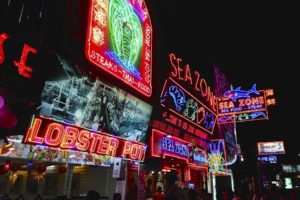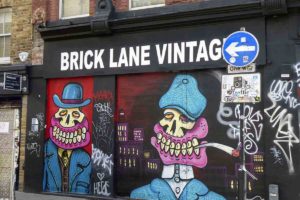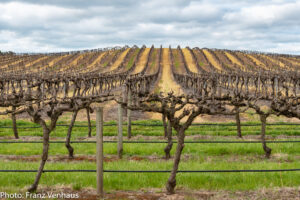We got lucky when we phoned Bamboo Delight Cooking School. The cooking class we attended, the following morning, was a very informative, fun, and rewarding experience. Great value for money, delicious recipes to learn, and a veritable feast at the end of the class. To read all about this must-do activity click here
2. Red Mountain Estate and Winery
As lovers of red wine, we can’t pass up an opportunity to visit a winery. We didn’t have high expectations for the wines of Myanmar and were surprised to find them really quite good. The late harvest white is a nice drop for those with a sweet tooth, while their Syrah (Shiraz) was my firm favourite. With the stunning views and good food, we actually returned there for an afternoon of wine and food while we waited until it was time to catch the bus.
3. Local Markets
We love exploring local markets! Whether it is night markets, selling all the best food for dinner, or the local produce markets, we never miss an opportunity to wander in and explore. Nyuang Shwe had both. On our first night, we stumbled upon a night market with food stalls as well as a bar, where we enjoyed a cocktail and some delicious meat skewers! We also explored the local produce markets a couple of times.
Visiting the local markets is always fun. We love seeing the fresh fruit and vegetables, fish, meat, and all the strange things you can come across at the markets in exotic places. We also visited the local markets as part of our cooking class and having an English speaking guide to explain some of the things we were seeing was really helpful.
The next 7 experiences we discovered on a boat tour of Inle Lake.
4. Intha Fishermen
An interesting aspect of the lake tour is watching the fishermen using their unique technique of maneuvering their boats. They use their paddle with one leg leaving both hands free to work the nets. Not long after leaving the estuary and entering the main lake, we saw our first fisherman. Fully decked out in the traditional fishing garb and holding what I can only assume is a traditional fishing basket. I can tell a set up when I see one. Ok, so l believe this ‘fisherman’ is here for tourists to get the perfect shot and I loved it! I’m not sure how he makes his money though because our guide didn’t take us over to him to tip.
Don’t be put off with the staged fisherman because the technique is still being used every day by the local fishermen. As we motored across the lake, we saw many fishermen fishing with fish traps and nets. They also maneuvered their boats with one leg leaving both hands free to work with… it was riveting!
We also saw the villagers collecting boatloads of lake weed. This weed is used to create floating gardens. One thing we noted at this time was how clear the water was, and how shallow. The water was clear, and it was easy to see the mass of weed growing on the lake bottom.
5. Floating Gardens
Not long after watching the collection of lake weed we had reached the outskirts of a floating village. Soon we were negotiating narrow waterways between huge floating gardens. On either side of us, we could see rows and rows of tomato plants and people in boats doing the gardening. It was fascinating.
6. Floating Village
Although most of the village is not floating on the water per se, it is constructed on stilts over the water of the lake and hence called a floating village. The people of the village get from house to house, shop, restaurant, or work via a boat. Some of the homes looked quite, but many are grand buildings! It is a very different way of life, and although we have seen small fishing communities in other southeast Asian countries living over the water, we have never seen a community quite this large or as complex.
7. Silversmith
Our first stop in the village was at the silversmith. As we arrived, we were met by a small floating market – local people in boats selling their wares. We didn’t purchase anything from the floating market at this stage but went into the silversmith workshop/shop. Here we were met by a beautiful Burmese lady who explained to us the process of the silver starting from where it is mined in the mountains. I actually found it fascinating to listen to and watch the silversmiths working. There is then a shop you can browse – no hard sell here – we were allowed to browse and could have easily moved on without buying anything, but I was wanting a little silver band and actually ended up making two small purchases that were very reasonably priced.
8. In Dien Stupas
Next, we were taken up the In Dein River to see the stupas of In Dien. We were absolutely stunned by what we found here. We thought we’d done the “pagoda thing” at Bagan, but here we were walking, once again, amongst the ruins of hundreds of stupas. The building of these stupas began in the 12th century, and it appears new ones are still being built here. However, it was the old, ruined stupas, barely reclaimed from the jungle, that held our attention, and yes it felt a little Indiana Jones/Lara Croft as we explored!
There is a long corridor, leading to the central pagoda where you will see many souvenir stalls selling all sorts of paraphernalia. But it was the people we met at the markets that held our interest. At a booth at the far end of the corridor, some women offered us some of the food they were eating when Dwayne showed an interest. It was a delicious tea leaf salad. Then we came across a cigar-toting weathered woman who was more than happy to pose for us.
9. Weaving
This stop was fascinating! This is where I first saw that you can use lotus for weaving. Myanmar is the only place that makes lotus fabric. We were shown how they retrieve the fibre from the lotus and how it was made into beautiful cloth. It is extraordinary and lovely to the touch. We also had a tour of the cotton and silk weaving before we were taken to the weaving shop. There was no hard sell, and again I felt I could have easily thanked them for their time and moved on without making a purchase. I did, however, buy a scarf because they are cheap and they always come in handy!
10. Cigars
Neither Dwayne nor I smoke (anymore), but we enjoyed this stop. At the cigar shop, we watched the girls hand-roll regular and sweet cigars, and we were given a sweet cigar to try… and we really enjoyed it (sorry lungs!). The sweet ones are so smooth. Honestly, if I knew smoking wouldn’t kill me, and it was actually good for me, I would have bought out their entire stock of sweet cigars! Again we felt no hard-sell tactics, but we did purchase a couple of cigars to give to the boatman.
Travel Notes (2017)
Currency
MMK – Burmese Kyat written here as K
You will sometimes be quoted in USD and it is easy enough for them to convert to Kyat (pronounced chat). In my opinion, I think it is better to have the Kyat as everyone takes that. If you have USD they need to be in perfect condition. TIP – change or use all your Kyat before you leave Myanmar because it is not easy to get it changed once you leave. We have had no luck changing it in Thailand or Malaysia so far.
Inle Zone Entrance
Cost – K12,000 (for 5 years and above)
Valid – 5 days from the date of issue
We paid this on our way from the bus to the hotel… the taxi driver just stopped at where we had to pay.
Bamboo Delight Cooking School
Cost – K20,000 per person (less than AUD 20.00)
Class Hours – Morning class (includes market trip) 09:00 – 13:00 / Evening class 17:00 – 20:00
Phone – 081-209375, 09 41010433, 09 428345261
Email – [email protected]
Website – https://bamboodelight.wordpress.com/cooking-class/
Red Mountain Estate and Winery
Cost – K5000 per person for tasting. The tasting includes four wines (2 x white, 2 x red) & a bowl of peanuts
Open hours – daily 09:00 – 18:00
Location – Taung Chay Village Group, Nyaungshwe Township, Southern Shan State
Phone – +95-01-664970, +95-01-652662 +95 81 209 366
Getting there – we hire bicycles for about K2000 (less than AUD 2.00)
Restaurant – Glasses of wine K2500 – K4000. Example of food prices – French fries K2000, pork ribs K3500, tea leaf salad K2500, Thai basil beef K3000.
Boat Trip on Lake
Cost – K25,000 for the two of us in one boat. (less than AUD 25.00 – we have heard people pay a lot more – it was off-season).
Location – The boatman approached us as we were leaving our hotel for a walk. We agreed on a price and he met us at the hotel the next day and took us to the boat.
Our boatman supplied life jackets, umbrellas, and rain jackets.
Accommodation
We stayed at the Royal Nyaung Shwe Hotel which we booked through booking.com at a great price!
Cost – USD 25.00
Pros – New hotel, A/C, fridge, good size room, large bathroom, extra pillows, desk, bedside tables, kettle, good range of toiletries, two English movie channels, lift/elevator, wifi ok and friendly helpful staff.
Cons –No pool yet, but I think they said they are going to be doing one – on the roof maybe?
Verdict–The room was a good size and really nice. Breakfast was included – we could order what we wanted tea/coffee/juice/fruit/eggs/toast/cereal/noodles/rice etc. I would stay there again.
Transport
Getting there – Bus from Bagan to Nyaung Shwe (Inle lake)
Cost – K11000 / per person (less than AUD 11.00)
Company – Rainbow Express
Departed – 08:00 (We got picked up at 07:30)
Comfort – Not good. We ended up getting picked up by a minivan. We thought the van would be taking us to the bus because we said we wanted VIP/Express. It didn’t. We picked up more people along the way until the minivan was full. We had many unexplained stops and didn’t arrive until about 17:00 at Nyaung Shwe. It was a long day. We chose to go by day bus because we were told it was only a 6-hour trip and apparently we would be dropped at Nyaung Shwe in the middle of the night (on the night bus). I would not do this trip again by day bus.
Moving on– Overnight bus from Nyaung Shwe to Mandalay
Cost – K16,000 per person (less than AUD 16.00)
Company – Shan Thit Sar Express
Departed – 19:30 (we were picked up from our hotel at 19:00)
Comfort – Very good, A/C, blanket. Arrived in Mandalay at 03:30 (the hotel let us in our room!)
Myanmar Travel/Visa
It is now very easy to apply for a visa to travel to Myanmar. You simply apply for an eVisa online before you travel. Your tourist eVisa will be valid for 90 days from the date of issue and you may stay in Myanmar for up to 28 days from the date of arrival.
How to apply – Simply visit https://evisa.moip.gov.mm/ and fill in an online form. You will need to attach copies of your passport and also a passport photo. To attach our copies we simply took photos and uploaded them. When applying you need to tell them where you plan on entering Myanmar, your accommodation details (we simply put down where our first-night accommodation was) and you will need a credit card for payment.
You should receive confirmation of your visa application via email within one hour. Within three days you should receive your approval letter. You need to print out the letter and take it with you. You will be expected to present it on arrival in Myanmar.
Wifi/Sim Card
We found that the wifi wasn’t always good at the hotels. Having said that we did get lucky in a couple of places and had very good wifi. We each bought a sim card for our phone/iPad at the airport in Yangon when we flew in. I had read somewhere that ooredoo was good and I was not disappointed with my connection. We paid K22,500 for 14Gb and 30mins calls. I think 6Gb and 30min calls were K11,500.
Liked this post! Why not share it with your friends and family….. thank you!













19 Comments
Leave your reply.